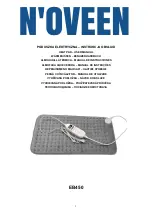
15
proper operation.
6. Compressor contractor closes its contacts L1, L2
and L3 to T1, T2 and T3 to provide power to the
compressor motor COMP 1; COMP 2, if conditions
are correct. In addition, contractor C1 closes its
contact L3 to T3 , energizing the condenser fan motor.
WARNING
BURN HAZARD!
DO NOT TOUCH! DISCHARGE LINE MAY BE HOT!
7. Check that each compressor is operating correctly.
The scroll compressors in these units MUST operate
in the proper rotation. To ensure the compressors
are operating in the correct direction, check the
compressor discharge line pressure or temperature
after each compressor is started.
The discharge pressure and discharge line
temperature should increase. If this does not occur
and the compressor is producing an exceptional
amount of noise, perform the following checks.
• Ensure all compressors and the supply fan
motor are operating in the proper direction. If a
single motor is operating backwards, check the
power wiring for that motor and correct any leads
that have been interchanged at the contractor or
at the motor.
• If all of the motors are operating backward,
disconnect the unit power supply and lock
it in the “OFF” position. Switch two leads
of the power supply at the unit Single Point
Power Block. Reconnect power and check for
compressor and supply fan motor operation.
8. With all safety devices closed, the system will
continue cooling operation until the thermostat is
satisfied.
9.
Disconnecting the jumper wire between R and Y1 and
Y2 and between R and G on TB1 terminal block will
simulate a satisfied thermostat. The compressors
will cycle off and IIC (pin 12) will initiate its time delay
cycle. The compressor and the supply fan will cycle
off.
10. After a time delay of approximately 3 minutes, the
compressor control circuits will be ready to respond to
a subsequent call for cooling from the wall thermostat.
11.
Open disconnect switch. Reconnect the field
thermostat wire at terminal R on terminal block TB1.
Start-up Procedure and Checklist for 2 Speed
Models:
Models with V or S in the 8th position of the model number.
For 2 speed models, the indoor blower will operate on
low speed when in “Fan Only” mode or while in first
stage “Cooling” mode. Unit will operate on high speed
in “Heating” mode and while in second stage “Cooling”
mode.
The same start-up procedure should be followed as in
Start-Up Procedure and Checklist with the understanding
that in Step 6 the indoor blower will run at low speed and in
Step 7 the indoor blower will operate at high speed.
NOTE: While in the Cooling Mode, to prevent frost
from forming on the evaporator while the unit
is operating in outdoor temperatures of 65°F or
lower, it is recommended that a low ambient kit
(LAKT-**) is used. This is strongly recommended
for 2 Speed models due to the lower airflow
while in the first stage cooling. To further
protect the compressor from damage during low
ambient conditions, a Freezestat Kit (FSK01) can
be added that turns the compressor off when the
evaporator temperature drops too low.
WARNING
HIGH VOLTAGE!
Disconnect all power before
servicing or installing this unit.
Multiple power sources may be
present. Failure to do so may cause
property damage, personal injury or
death.
Refrigeration Performance Check
Check that compressor RLA corresponds to values shown
in Appendix B. RLA draw can be much lower than values
listed at low load conditions and low ambient condensing
temperatures. Values in Appendix B can slightly exceed
at high load conditions and high ambient condensing
temperatures.
Final System Checks
1. Check to see if all supply and return air grilles are
adjusted and the air distribution system is balanced
for the best compromise between heating and cooling.
2. Check for air leaks in the ductwork. See Sections on
Air Flow Adjustments.
3. Make sure the unit is free of “rattles”, and the tubing
in the unit is free from excessive vibration. Also make
sure tubes or lines are not rubbing against each other
or sheet metal surfaces or edges. If so, correct the
trouble.
4. Set the thermostat at the appropriate setting for
cooling and heating or automatic changeover for
normal use.
5.
Be sure the Owner is instructed on the unit operation,
filter, servicing, correct thermostat operation, etc.
Содержание DBC Series
Страница 44: ...44...
Страница 45: ...45...
Страница 46: ...46 THIS PAGE IS INTENTIONALLY LEFT BLANK...
Страница 47: ...47 THIS PAGE IS INTENTIONALLY LEFT BLANK...
















































